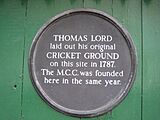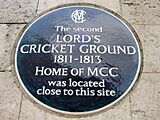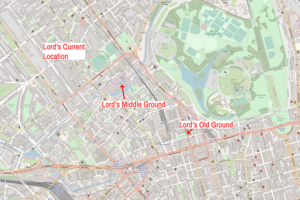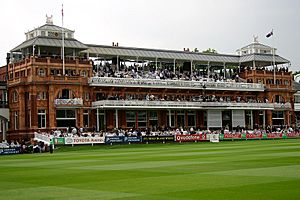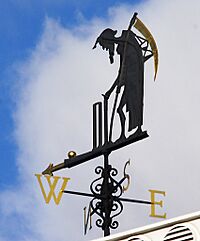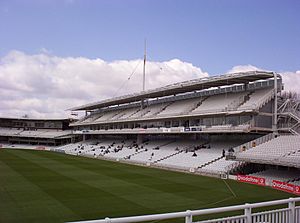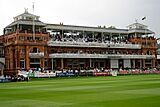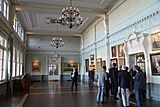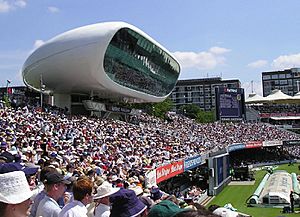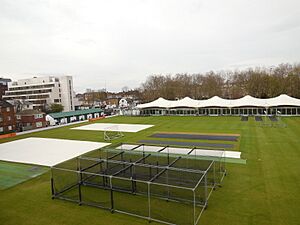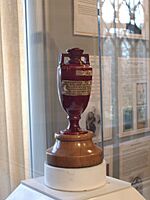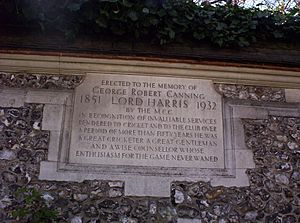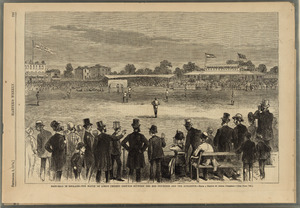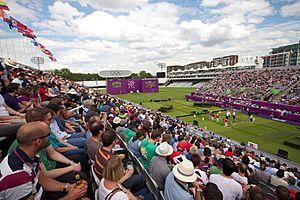Lord's facts for kids
| The Times of Cricket | |||||
 |
|||||
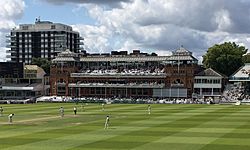
The Pavilion
|
|||||
| Ground information | |||||
|---|---|---|---|---|---|
| Location | St John's Wood, Westminster, Greater London, England | ||||
| Coordinates | 51°31′46″N 0°10′22″W / 51.5294°N 0.1727°W | ||||
| Establishment | 1787 at Lord's Old Ground; 1814 at the current grounds | ||||
| Capacity | 31,100 | ||||
| Owner | Marylebone Cricket Club | ||||
| Tenants | England and Wales Cricket Board | ||||
| End names | |||||
Nursery End 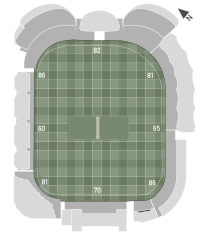 Pavilion End |
|||||
| International information | |||||
| First Test | 21–23 July 1884: |
||||
| Last Test | 10–14 July 2025: |
||||
| First ODI | 26 August 1972: |
||||
| Last ODI | 27 September 2024: |
||||
| First T20I | 5 June 2009: |
||||
| Last T20I | 29 July 2018: |
||||
| First WODI | 4 August 1976: |
||||
| Last WODI | 24 September 2022: |
||||
| First WT20I | 21 June 2009: |
||||
| Last WT20I | 17 July 2024: |
||||
| Team information | |||||
|
|||||
| As of 15 June 2025 Source: ESPNcricinfo |
|||||
Lord's Cricket Ground, often called Lord's, is a famous place for cricket in St John's Wood, Westminster. It's named after its founder, Thomas Lord. The Marylebone Cricket Club (MCC) owns it, and it's home to the Middlesex County Cricket Club, the England and Wales Cricket Board (ECB), and ICC Europe. Until 2005, the International Cricket Council (ICC) was also based here.
Lord's is known as the Home of Cricket and has the world's oldest sports museum. The current Lord's is actually the third ground Thomas Lord created between 1787 and 1814. His first ground, Lord's Old Ground, is now where Dorset Square is. His second, Lord's Middle Ground, was used from 1811 to 1813. It had to close for the Regent's Canal to be built. The current Lord's is about 250 yards (228 meters) north-west of the Middle Ground. The stadium can hold 31,100 fans, a number that grew between 2017 and 2022 as part of the MCC's plans to make it even better.
Contents
The Story of Lord's Cricket Ground
How Lord's Began
In May 1787, Thomas Lord opened his first cricket ground. It was on land leased from the Portman Estate, where Dorset Square is now. He did this for members of the White Conduit Club. They moved from Islington because they weren't happy with their old ground. They then became the Marylebone Cricket Club (MCC). The first game at this new ground was between Middlesex and Essex.
In 1811, Lord had to move his ground because the rent went up. He moved his turf to his second ground, Lord's Middle Ground. But this ground was also short-lived. It was in the way of the planned Regent's Canal, and fans didn't like it much.
The Eyre family, who owned the land for the "Middle Ground," offered Lord another spot nearby. So, he moved his turf again. This new ground, opened in 1814, was once a duck pond on a hill in St. John's Wood. This is why Lord's has its famous slope, which goes down about 8 feet (2.4 meters) from north-west to south-east. The first match at this new ground was on June 22, 1814, between the MCC and Hertfordshire.
Early Days of Cricket at Lord's
A tavern (a type of pub) was built for Lord in 1813–14, and a wooden pavilion (a building for players and officials) followed in 1814. The first important cricket match (called first-class) was played here in July 1814. The MCC played against the St John's Wood Cricket Club.
The first time a player scored 100 runs (a century) at Lord's was by Frederick Woodbridge in 1814. The yearly Eton v Harrow match, which started in 1805, returned to Lord's in 1818 and has been played there almost every year since.
In 1820, William Ward scored 278 runs, the first "double-century" in first-class cricket. The original pavilion burned down in 1823, destroying many old MCC records. Lord quickly rebuilt it. In 1825, Lord thought about building houses on the ground, but William Ward saved it by buying it for £5,000.
The first University Match between Oxford and Cambridge was held at Lord's in 1827. This became the oldest first-class match in the world until 2020. The ground was owned by Ward until 1835, then by James Dark. Improvements were made over time, like a telegraph scoreboard in 1846 and drainage in 1849–50.
The Australian Aboriginal cricket team played at Lord's in 1868. In 1866, the boundary system was introduced because crowds were getting too big and getting onto the field. Turnstiles were added in 1871 to help control the crowds.
Growing and Developing Lord's
Middlesex County Cricket Club, started in 1864, began playing at Lord's in 1877. In 1873–74, a bank was built for 4,000 spectators. The pitch quality at Lord's was often criticized, but it got much better after Percy Pearce became Ground Superintendent in 1874.
The Australian cricket team first played at Lord's in 1878, beating the MCC. This game helped start the famous rivalry between England and Australia. Lord's hosted its first Test match in 1884 during the Ashes series. England won this match.
In 1889–90, a new, larger pavilion was built, designed by Thomas Verity. The old pavilion was moved and used as a garden shed. Soon after, the MCC bought the land to the east, now called the Nursery Ground. This area was once a market garden that grew pineapples and tulips.
The Manchester, Sheffield and Lincolnshire Railway wanted to buy the Nursery Ground for their railway line. The MCC gave them a small strip of land, and in return, they got the Clergy Orphan School to the south. Tunnels for the railway were built under the Nursery Ground between 1894 and 1898. After the tunnels were done, the railway company laid a new pitch.
The Mound Stand was built in 1898/99. In 1899, Albert Trott hit a six over the pavilion, a feat no other batsman has done since. The Imperial Cricket Conference was founded at Lord's in 1909.
During the First World War, Lord's was used by the British Army. Cooking and wireless classes were held there, and the pavilion was used to make hay nets for horses on the Western Front. Even so, Lord's hosted charity cricket matches during the war.
Between the Wars and World War II
Cricket returned to Lord's in 1919. In 1923, the Grace Gates were installed as a tribute to W. G. Grace, a famous cricketer who died in 1915. A new grandstand was built in 1926, designed by Sir Herbert Baker. He also gave Lord's a weather vane called Father Time, which shows a figure removing the bails from a wicket. It's 6 feet 6 inches (1.98 meters) tall.
Lord's hosted the first televised Test match in 1938. Unlike the First World War, Lord's was not taken over by the military during the Second World War. It hosted matches and was mostly spared from bomb damage. However, Father Time was damaged in 1944 when a barrage balloon broke loose and hit it. International cricket started again after the war.
After the Wars
After World War II, many people came to watch cricket. The Warner Stand was built in 1958, adding snack bars and a press box. This stand replaced an area where people used to watch from their carriages.
To bring more fans back, one-day cricket was introduced in 1963. Lord's hosted its first one-day match and the first-ever one-day final in the world in 1963. The tavern was rebuilt in 1968 to make way for the Tavern Stand. Lord's hosted its first One Day International (ODI) in 1972. It also hosted the final of the first men's World Cup in 1975 and again in 1979.
The first women's cricket match at Lord's was in 1976. Lord's hosted the final of the ICC Women's Cricket World Cup in 1993, where England won.
A new indoor cricket school was built in 1973. In 1983, the West Indies played in their third World Cup final at Lord's but lost to India. The Mound Stand got a new upper level in 1987.
Graham Gooch scored the first Test match triple-century (333 runs) at Lord's in 1990. The 1990s saw many updates at Lord's. The Compton and Edrich stands were finished in 1991. A new indoor cricket center opened in 1995. The old Grandstand was replaced in 1998.
Lord's hosted three matches in the 1999 World Cup, including the final. For this, the Media Centre was built between the Compton and Edrich stands. It was opened in April 1999.
Lord's in the 21st Century
Lord's hosted its 100th Test match in June 2000. The famous Lord's slope, which helps bowlers, was almost leveled, but the MCC decided to keep it. The outfield was relaid in 2002 to improve drainage. Lord's hosted its first Twenty20 match in 2004. In 2005, the International Cricket Council moved its headquarters from Lord's to Dubai.
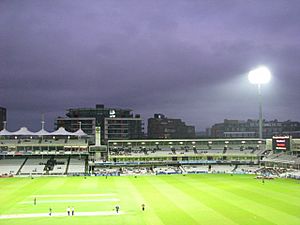
Temporary floodlights were put up in 2007 but removed in 2008 due to complaints. In 2009, new, retractable floodlights were approved and first used on May 27, 2009. Lord's hosted its first Twenty20 International in the World Twenty20 that year, and also the final.
In 2013, the Lord's Masterplan was revealed, a 20-year plan to improve the ground. The Warner Stand was rebuilt between 2015 and 2017. The Compton and Edrich Stands were rebuilt between 2019 and 2021, adding 2,000 seats.
Lord's celebrated its 200th anniversary in 2014 with a special match between an MCC team led by Sachin Tendulkar and a Rest of the World team led by Shane Warne.
In July 2019, Lord's hosted the 2019 World Cup Final between England and New Zealand. It was a tied match, and England won based on scoring more boundaries. Four days later, Ireland played their first Test match at Lord's. Ireland bowled England out for 85 runs but then were bowled out for 38 runs themselves, the lowest Test total at Lord's.
In August 2022, the East Gate was renamed the Heyhoe Flint Gate to honor Rachael Heyhoe Flint.
What You'll Find at Lord's
Stands for Spectators
As of 2025, the stands at Lord's are (going clockwise from the Pavilion):
Many stands were rebuilt in the late 1900s. The new Mound Stand opened in 1987, and the Grand Stand in 1996. The Media Centre, where journalists work, was added in 1999. It's between the Compton and Edrich Stands. The Compton and Edrich Stands were updated in 2021, adding 2,600 seats and bringing the total capacity to 31,100.
The two ends of the pitch are the Pavilion End (south-west), where the main members' pavilion is, and the Nursery End (north-east), where the Media Centre is.
The Famous Pavilion
The current pavilion at Lord's is the third one and is a key building from the Victorian era, built in 1889–90. It's a special Grade II* listed building. It's made of brick with fancy terracotta decorations. The building has a long, two-story middle section with covered seating and two towers.
The pavilion's roof terrace on the second floor offers great views of the whole ground. It was updated in 2004–05. The pavilion is mainly for members of the MCC, who can use its facilities like viewing seats, the Long Room, and bars. For Middlesex matches, members of the Middlesex County Cricket Club can also use it. The pavilion also has the dressing rooms for players, each with a small balcony.
The Long Room is on the ground floor of the pavilion. It's famous for being the path players take from their dressing rooms to the cricket field. This walk can be tricky; one player, David Steele, got lost on his debut in 1975 and ended up in the basement toilets! The Long Room is decorated with paintings of famous cricketers. It's a great honor for an overseas player to have their portrait there.
In the players' dressing rooms are the Lord's honours boards. These boards list players who have scored centuries, taken five wicket hauls (5 wickets in an innings), or ten wicket hauls (10 wickets in a match). There are boards for Test matches and, since 2019, for ODIs. As of 2025, 167 players have scored 240 Test centuries at Lord's.
The dress code in the pavilion is very strict. Men must wear "ties and tailored coats and acceptable trousers with appropriate shoes." Women must wear "dresses; or skirts or trousers worn with blouses, and appropriate shoes." Until 1999, women were not allowed in the pavilion as members during play.
The Media Centre
The Media Centre was built for journalists and commentators. It was approved in 1996 and built between the Compton and Edrich Stands. It stands 15 meters (49 feet) above the ground on strong supports. This design allows people and equipment to move easily between the main ground and the Nursery Ground.
It was designed by Future Systems and was the first all-aluminum, semi-monocoque building in the world, costing about £5 million. It was built in 32 parts and put together at Lord's in 1998. The front windows are tilted to stop reflections and glare on the pitch. The Media Centre has space for 118 journalists and boxes for radio and TV commentators. It won eight architectural awards, including the RIBA Stirling Prize in 1999.
The Nursery Ground
The Nursery Ground was bought by the MCC in two parts in 1838 and 1887. It's mainly used for practice and has some of the best grass nets in the world. The Nursery Pavilion, built in 1999, overlooks this area and is one of London's largest event venues.
The Nursery Ground hosted one first-class cricket match in 1903. The Women's University Match has been played here since 2001. However, starting in 2022, the 20-over women's match will be played on the main Lord's ground. On big match days, fans can go onto the outfield. The Cross Arrows Cricket Club plays its home matches here. The new Compton and Edrich stands took up some of the Nursery Ground's space. To get that space back, the temporary Nursery Pavilion will be taken down in 2025–26, and the playing area will be made larger.
MCC Museum and Library
Lord's is home to the MCC Museum, the oldest sports museum in the world. It has the most famous collection of cricket items, including The Ashes urn. The MCC has been collecting items since 1864. These items were first shown in the pavilion, only for MCC members. After World War II, the collection grew too big. It was moved to an old rackets court and opened to the public in 1953.
The museum welcomes about 50,000 visitors each year. You can see cricket gear used by famous players like Don Bradman and Shane Warne. There's also a stuffed sparrow that was "bowled out" by Jahangir Khan in a match in 1936! The museum also has a cinema that shows old cricket videos.
Lord's also has one of the biggest collections of cricket books. The library has over 20,000 books and adds about 400 new ones each year. It's a private library for MCC members on match days but is open by appointment on other days.
Gardens at Lord's
Lord's has two gardens: the Harris Garden and the Coronation Garden. The Coronation Garden was made in 1952 to celebrate the Coronation of Elizabeth II. It has trees and benches, a nice shaded area. It also has an old, heavy roller from the 1880s that was used at Lord's until 1945. A large bronze statue of W. G. Grace stands here.
The Harris Garden, once tennis courts, became a rose garden in 1934 to remember Lord Harris. It was restored in 2018. The flower beds now feature flowers from all the Test playing nations.
Other Sports Played at Lord's
Besides cricket, Lord's has hosted other sports. Real tennis has been played here since 1838. A real tennis court was built for £4,000, a lot of money back then. Rackets has also been played at Lord's since 1844.
In 1875, the MCC helped create the first official rules for lawn tennis. The dimensions of the tennis courts at Lord's were used as a basis for these rules. These courts are now part of the Harris Garden.
Archery was played at Lord's as early as 1844. Lord's was also a venue for the 2012 Summer Olympics, hosting the archery competition. Archers stood in front of the pavilion, shooting at targets 70 meters away.
Lacrosse was first played at Lord's in 1833 by Canadian pioneers. Exhibition matches were held in 1876 and 1883. Baseball was first played at Lord's in 1874, with American teams like the Boston Red Stockings playing. A baseball game was also held during the First World War to raise money.
Lord's hosted a field hockey tournament in 1967 before the 1968 Olympics. The University Match between Oxford and Cambridge hockey clubs took place at Lord's for 21 years starting in 1969.
Other sports played at Lord's include lawn bowls and billiards. In the late 1840s and early 1850s, Lord's even held Galloway pony races!
International Cricket Records at Lord's
Test Matches
- Highest team score: 729/6 declared by Australia vs. England, 1930
- Lowest team score: 38 all out by Ireland vs. England, 2019
- Highest individual score: 333 by Graham Gooch for England vs. India, 1990
- Best bowling in one innings: 8/34 by Ian Botham for England vs. Pakistan, 1978
- Best bowling in a match: 16/137 by Bob Massie for Australia vs. England, 1972
One Day Internationals (ODIs)
- Highest team score: 334/4 (60 overs) by England vs. India, 1975
- Lowest team score: 107 all out (32.1 overs) by South Africa vs. England, 2003
- Highest individual score: 138* by Viv Richards for West Indies vs. England, 1979
- Best bowling in one innings: 6/24 by Reece Topley for England vs. India, 2022
Twenty20 Internationals (T20Is)
- Highest team score: 199/4 (20 overs) by West Indies vs. ICC World XI, 2018
- Lowest team score: 93 all out (17.3 overs) by Netherlands vs. Pakistan, 2009
- Highest individual score: 78 by Mahela Jayawardene for Sri Lanka vs. Ireland, 2009
- Best bowling in one innings: 4/11 by Shahid Afridi for Pakistan vs. Netherlands, 2009
Domestic Cricket Records at Lord's
First-class Matches
- Highest team score: 655 by Middlesex vs. Glamorgan, 2024.
- Lowest team score: 15 by MCC vs. Surrey, 1839
- Highest individual score: 335* by Sam Northeast for Glamorgan vs. Middlesex, 2024.
- Best bowling in one innings (complete records): Samuel Butler's 10 for 38 for Oxford University vs. Cambridge University in 1871.
- Most wickets in a match: 18 by William Lillywhite for the Players vs. Gentlemen in 1837.
List A Matches
- Highest team score: 368/2 (50 overs) by Nottinghamshire vs. Middlesex, 2014
- Lowest team score: 57 (27.2 overs) by Essex vs. Lancashire, 1996
- Highest individual score: 187* by Alex Hales for Nottinghamshire vs. Surrey, 2017
- Best bowling in one innings: 7/22 by Jeff Thomson for Middlesex vs. Hampshire, 1981
Twenty20 Matches
- Highest team score: 223/7 (20 overs) by Surrey vs. Middlesex, 2021
- Lowest team score: 90 (14.4 overs) by Kent vs. Middlesex, 2015
- Highest individual score: 102 not out by Stephen Eskinazi for Middlesex vs. Essex, 2021
- Best bowling in one innings: 6/24 by Tim Murtagh for Surrey vs. Middlesex, 2005
More to Explore
- List of cricket grounds by capacity
- Lists of stadiums
See also
 In Spanish: Lord's Cricket Ground para niños
In Spanish: Lord's Cricket Ground para niños


